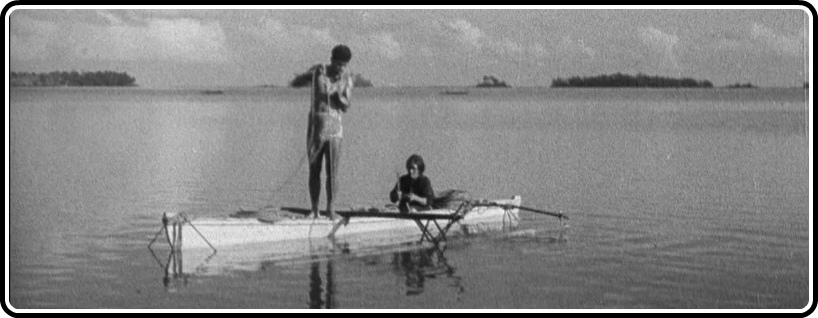
In an age in which filmmakers are increasingly publicly irate about studios shutting down financing for passion projects that may not at first appear to have great commercial value, now is a great time to reconsider what would come to be F.W. Murnau’s final film, Tabu. Having burst onto the Hollywood scene to great acclaim with 1927’s Academy-Award-winning Sunrise, his next two films – the now-lost Four Devils in 1928 and City Girl in 1930 – were considerably less enthusiastically received, and he, having lost whatever illusions about Hollywood he might have still entertained, followed what surely would have been Barry Zuckerkorn’s advice, and took to the sea.
Specifically, he bought a yacht, enlisted the services of Robert Flaherty (director of, most famously, Nanook of the North) and his brother, David, and sailed to the Tahiti with the intent of making a film there. When the (already independent) financing arrangement dried up, he didn’t run to the press and talk about how the studio system doesn’t support “real” visions or whatever, but rather pulled what remaining money he had together, and financed the whole damn thing himself. Like a boss.
He dismissed his Hollywood crew, trained natives to do their work, and, after finding the language barrier between himself as the Tahitians virtually non-existant (each camp spoke excellent French), dissolved his partnership with Flaherty, whose working methods could not possibly have been more different than Murnau’s. His final contributions to the film amount to a story credit and the first few minutes of the film. Murnau produced the remainder of the film on his own; cinematographer Floyd Crosby (who won an Academy Award for his work) was the only other Hollywood professional on the shoot.
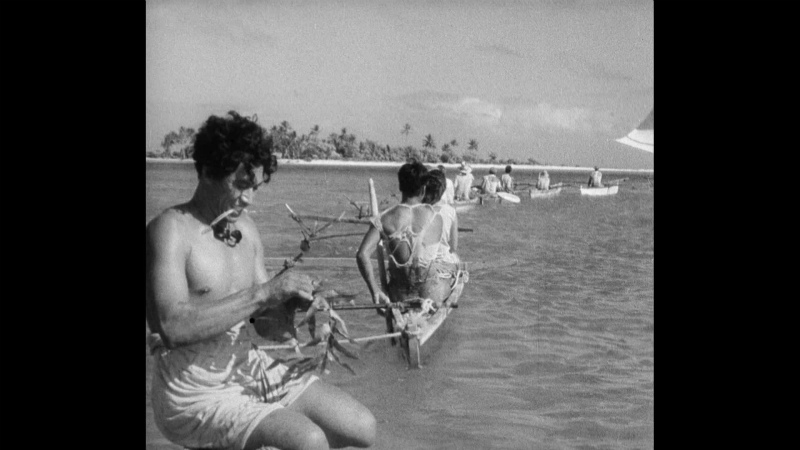
The result really feels like something completely removed from any other filmmaking at the time, certainly in America (the film’s eventual country of origin, after a distribution arrangement was reached with Paramount). The setting alone, with non-white actors as the leads and very few, brief appearances by white actors at all, separates it considerably from the pack. Shot as a silent film, the synched score Murnau enlisted Hugo Riesenfeld to craft is uniquely in concert with the morals, themes, and texture of the picture, never quite immersing us in the reality of the environment, but soaking us in its feeling.
Further, it avoids the trappings of the exotic-locale picture that would plague Hollywood for decades to come, and is still painfully prominent. While the leads fall somewhat into the “noble savage” trope, their status is not so different from the heroes of any other tale that extensively employs archetypes. Besides, their true downfall eventually comes only indirectly from the White Man – The Boy’s (Matahi) debts to drink prevent him from securing passage for him and The Girl (Anne Chevalier) he loves in a crucial moment. Further, the root of their conflict is not from the White Man’s invasion (their village actually becomes an escape), but from the traditions of their own people. The Girl is set to become a sacred virgin for a nearby tribe, which is a great honor and all, except for it preventing her from being touched, let alone “looked upon with desire,” which is more than a little intrusive on the love she shares with The Boy.
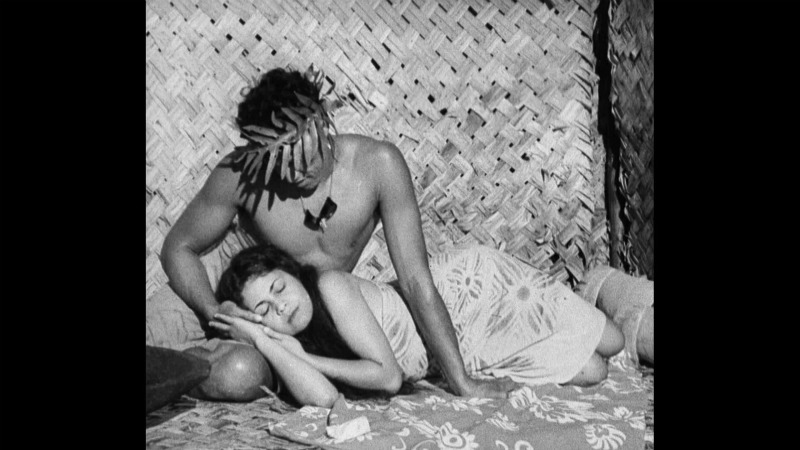
Murnau wrings this slight premise for every ounce of tension, melancholy, dread, and passion any story could possibly bear. For those who love Terrence Malick’s fall-of-Eden narrative, this is an absolutely essential work (and much more explicit about the theme, given its two chapter titles – “Paradise” and “Paradise Lost”), never mind the many aesthetic similarities. Though he still exhibits the sort of careful management of people within his frames that defined his best-known films, Tabu shows a new side to the filmmaker, one more open to casting his camera out on a boat, allowing the waves to carry it along, or get lost in the rhythms of a dance and the spirit of the island community. It’s a deeply moving, very purely movie experience, using title cards in a similar way to his Last Laugh, in only being presented as written correspondence taking place in the context of the story. It covers some needed exposition, but the emotions are purely in images.
Masters of Cinema brings this great film to the masses in a gorgeous (Region-B locked) Blu-ray edition. I really can’t speak highly enough of this transfer, which has all the density and shimmer that these old nitrate prints produce, and while the film has certainly seen some wear and tear (starting with its very production, as outdoor shoots of the era tend to look a little rougher), the essential integrity is far from lost. MoC got this very crisp, obviously stopping short of damaging the grain structure, which is fairly heavy, but seems to be fairly necessary. This is just about as good as any transfer from the era I’ve seen (very different from MoC’s much-acclaimed work on City Girl, but no less grand). These screencaps are resized and compressed, but look at how fine the contrast is on this next frame, genuinely descending into pitch-black darkness without any sense of over-sharpening or separation. As these things go, it looks even better in motion.
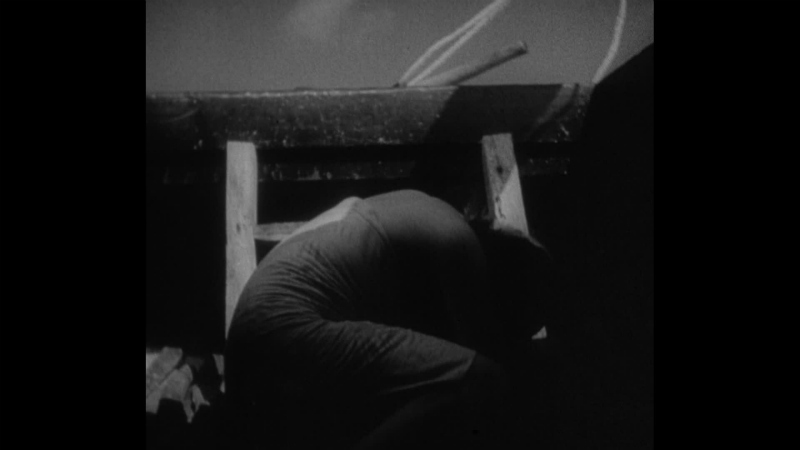
The issue of Tabu‘s aspect ratio is somewhat knottier than it may initially appear. Made during the silent-to-sound transition time, the film was shot in standard Academy ratio (1.33:1), which is how it’s been presented on home video to this point, but actually crafted, in its final form, for 1.19:1, to make room in the physical film print for the optical synched sound track. So while some dream version of Tabu exists wherein we can see the whole picture (outtakes available on this disc reveal quite a bit more information in the frame than in the final version), the correct version of the finished film is indeed 1.19:1, which is how Masters of Cinema presents it here, for the first time anywhere outside of an actual print. Having never seen the film in any form before this, I can’t imagine how butchered the 1.33:1 version must seem, as heads are dangerously close to being lopped off at various intervals even in this taller ratio, but we are certainly fortunate to have this available now.
The audio is a little worse for wear, sounding at times a little tinny, but it lapses into that very infrequently, and considering its age, I’m more than willing to cut it some slack. Moreover, for those of us who like old films or music or photographs or whatever to feel a little old, it certainly is not lacking in charm. Helps that Reisenfeld’s score is pretty astounding.
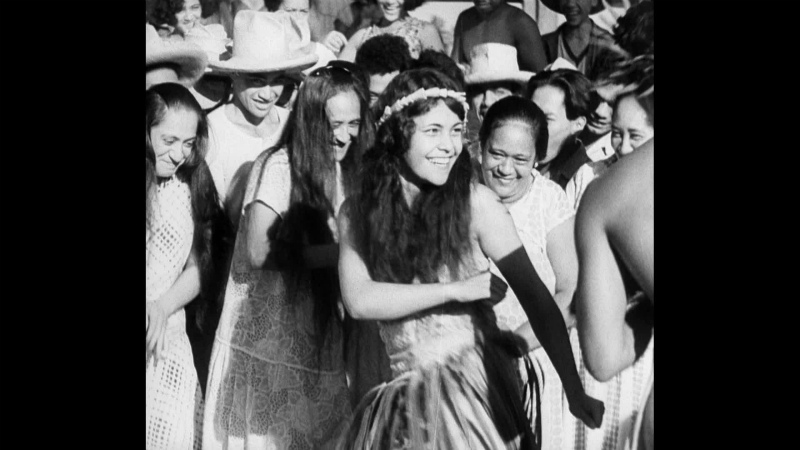
While I normally insist that MoC really makes their releases, which are often short on disc supplements, worthwhile because of their booklets, they also provide a pretty good chunk of disc supplements with this release. Best among them is a commentary track by R. Dixon Smith and Brad Stevens. Even if they speak at two very different volumes, sometimes making it a little tough to keep up, they provide a great deal of information and analysis, as well as just a little good old-fashioned adoration of the film (which I know isn’t everyone’s favorite trait of a commentary track, but one I love). It was recorded for the 2007 DVD edition, and it’s a little amusing to consider that when they get around to discussing the transfer, proclaiming that this, this is truly the best the film will ever look, although admitting that in five years or so they could be proved wrong, and, well, six years later, those very comments play over a much better transfer.
A 15-minute documentary for German television about the film ends up repeating a lot of information from the commentary and booklet, both of which are considerably more substantial, so those pressed for every 15 minutes they’ve got may want to skip this, though it has its own unique elements as well in interviewing Murnau’s niece and showing off some family artifacts (including the man’s death mask, which Greta Garbo commissioned! It’s creepy!).
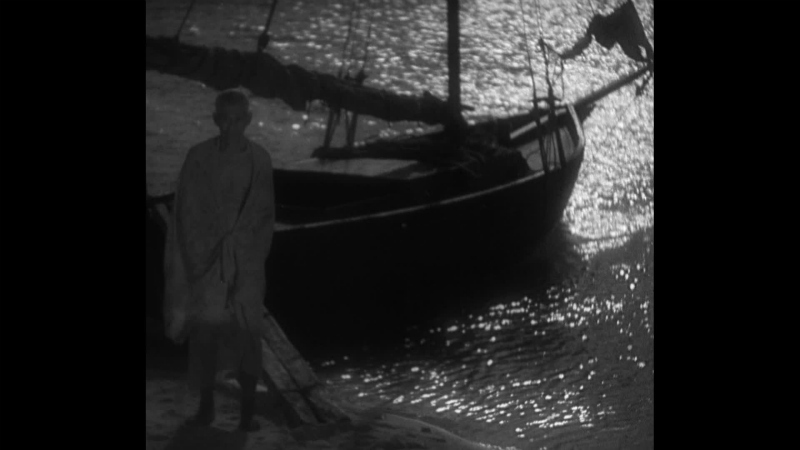
The previously-mentioned outtakes are indeed on the disc, and even if, like me, deleted scenes are far from your preferred supplemental material, this is actually pretty neat. For starters, you do get some images familiar from the film in the full 1.33:1 aspect ratio, and MoC accompanies them with some observations about the production (not a lot of new info, but illustrating stuff that was addressed elsewhere). It’s presented in HD.
Another feature making use of deleted scenes is a 1940 short subject entitled “Treibjagd in der Südsee,” which is a sort of observational documentary about fishing practices in Tahiti. While some of the scene before the hunt is obviously staged, it seems like Murnau (or even Flaherty, at that point) just asked the natives to go through the usual hunting routine (which is fairly elaborate, actually), and found a way to film that. It’s interesting on its own, but I’m glad it’s not a part of the main feature, as it would have halted the momentum. It’s presented in 1.33:1, and it also looked like high definition.
The booklet really tips the scales towards reenforcing this as a production-heavy release, and I’d recommend giving the booklet a read after listening to the commentary, but before everything else. It really goes a long way towards reenforcing a variety of perspectives on the history of the film. Scholar Scott Eyman’s update of an article from a 1990 issue of Film Comment is really exceptional, and the folks at MoC are good enough to provide scans of the script, with Murnau’s handwritten notes, to accompany this essay, which references them frequently. Notes by David Flaherty try to bridge the gap between his brother and Murnau, while an interview with Crosby mostly tries to set the record straight, he not being terribly inclined to credit Murnau where credit was not due, as their relationship was somewhat strained itself.
Following that is a good chunk of correspondence, some of it transcribed, other pieces scanned and replicated, that Murnau wrote to various people from Tahiti, some of them professionals in the industry, other pieces simply to his mother. Lastly, there is an excerpt from Murnau’s diary while in Tahiti. All in all, even someone totally unacquainted with the film’s history can gain a pretty great, succinct impression of what’s known about the production. Or so it seems from where I’m sitting. Between that bounty of material and the breathtaking nature of the film itself, this is the best Masters of Cinema release in a pretty stellar year thus far, and will likely remain near the top by year’s end. I highly, highly recommend picking it up.
Note: The below video was created in 2007 for the DVD release, and thus does not reflect the Blu-ray transfer in aspect ratio or quality. And, as an added note, it does contain nudity.




![Bergman Island (The Criterion Collection) [Blu-ray]](https://criterioncast.com/wp-content/uploads/2022/11/bergman-island-the-criterion-collection-blu-ray-400x496.jpg)
![This Is Not a Burial, It’s a Resurrection (The Criterion Collection) [Blu-ray]](https://criterioncast.com/wp-content/uploads/2022/11/this-is-not-a-burial-its-a-resurrection-the-criterion-collection-blu-ray-400x496.jpg)
![Lars von Trier's Europe Trilogy (The Criterion Collection) [The Element of Crime/Epidemic/Europa] [Blu-ray]](https://criterioncast.com/wp-content/uploads/2022/11/lars-von-triers-europe-trilogy-the-criterion-collection-the-element-of-400x496.jpg)
![Imitation of Life (The Criterion Collection) [Blu-ray]](https://criterioncast.com/wp-content/uploads/2022/11/imitation-of-life-the-criterion-collection-blu-ray-400x496.jpg)
![The Adventures of Baron Munchausen (The Criterion Collection) [4K UHD]](https://criterioncast.com/wp-content/uploads/2022/11/the-adventures-of-baron-munchausen-the-criterion-collection-4k-uhd-400x496.jpg)
![Cooley High [Criterion Collection] [Blu-ray] [1975]](https://criterioncast.com/wp-content/uploads/2022/11/cooley-high-criterion-collection-blu-ray-1975-400x496.jpg)
Excellent review, Scott. It is nice to know all the facts before spending the pounds. I produced the less exciting dvd for Image Entertainment in 2002, so it’s nice to know there is a worthy BD out there. Cheers…